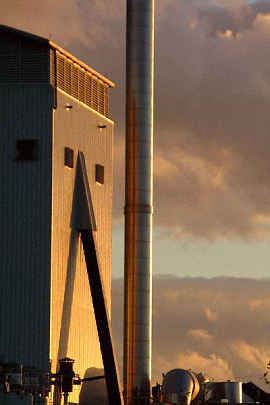Introduction
 In a process called "photosynthesis" (the reaction between plants, light, water and carbon dioxide) plants capture sunlight and transform it into chemical energy. This energy can then be converted into electricity, heat, or liquid fuels using a number of different conversion processes.
In a process called "photosynthesis" (the reaction between plants, light, water and carbon dioxide) plants capture sunlight and transform it into chemical energy. This energy can then be converted into electricity, heat, or liquid fuels using a number of different conversion processes.
Biomass is a versatile energy source. Organic matter that is used as a source of biomass energy includes trees, timber waste, wood chips, corn, rice hulls, peanut shells, sugar cane, grass cuttings, leaves, manure, sewage, and municipal solid waste.
All around the world people have used and are using woodstoves to heat their buildings and for cooking - making biomass one of the most common forms of energy.
According to the World Bank, 50-60% of the energy in developing countries of Asia, and 70-90% of the energy in developing countries in Africa comes from wood or biomass, and half the world cooks with wood.
In 2013 biomass energy provides 37% of the UK's renewable energy production, with plant biomass making up 21.6% of the several biomass energy options.
Biomass could supply a large part of the world's energy, through effective forest management, advance harvesting techniques and more efficient stoves and boilers.
The Theory of Biomass Energy
 Biomass is made up mainly of the elements carbon and hydrogen; we use technology to free the energy bound up in these chemical compounds.
Biomass is made up mainly of the elements carbon and hydrogen; we use technology to free the energy bound up in these chemical compounds.
There are several ways of capturing the stored chemical energy in biomass:
Direct Combustion is the burning of material by direct heat and is the simplest biomass technology and may be very economical if the biomass source is nearby.
Pyrolysis is the thermal degradation of biomass by heat in the absence of oxygen. Biomass is heated to a temperature between 400 and 750°C, but no oxygen is introduced to support combustion resulting in the creation of gas, fuel oil and charcoal.
Anaerobic Digestion converts organic matter to a mixture of methane, the major component of natural gas, and carbon dioxide. Biomass such as waterwaste (sewage), manure, or food processing waste, is mixed with water and fed into a digester tank without air.
Gasification biomass can be used to produce methane through heating or anaerobic digestion. Syngas, a mixture of carbon monoxide and hydrogen, can be derived from biomass.
Alcohol Fermentation fuel alcohol is produced by converting starch to sugar, fermenting the sugar to alcohol, then separating the alcohol water mixture by distillation. Feedstocks such as wheat, barley, potatoes, and waste paper, sawdust, and straw containing sugar, starch, or cellulose can be converted to alcohol by fermentation with yeast.
Landfill Gas is generated by the decay (anaerobic digestion) of buried garbage in landfills. When the organic waste decomposes, it generates gas consisting of approximately 50% methane, the major component of natural gas.
Congeneration is the simultaneous production of more than one form of energy using a single fuel and facility. Biomass cogeneration has more potential growth than biomass generation alone because cogeneration produces both heat and electricity.
Applications of Biomass
Biomass systems range from small stoves used in homes for heating or cooking to large power plants used by centralized utilities to produce electricity.
In residential applications, biomass can be used for space heating or for cooking. Wood is the most common source of fuel, although many different materials are used. New designs for woodstoves can improve the efficiency of the cooking or heating system, decreasing the amount of fuel that is needed.
Industry and businesses use biomass for several purposes including space heating, hot water heating, and electricity generation. Many industrial facilities, such as lumber mills, naturally produce organic waste.
More than 66,000 jobs are supported by the biomass producing industry in the US alone.
Biomass and the Environment
 Biomass absorbs carbon dioxide during growth, and emits it during combustion, therefore, it recycles atmospheric carbon and does not add to the greenhouse effect. It also does not contribute much to acid rain as it produces only low levels of sulfur and ash. Nitrous oxide production can be controlled through modern biomass combustion techniques.
Biomass absorbs carbon dioxide during growth, and emits it during combustion, therefore, it recycles atmospheric carbon and does not add to the greenhouse effect. It also does not contribute much to acid rain as it produces only low levels of sulfur and ash. Nitrous oxide production can be controlled through modern biomass combustion techniques.
Credits
Image: Biomass Energy by David Cornwell
Information sourced from:
Renewable energy in 2013 (2013), [online]. Available from: https://www.gov.uk/government/uploads/system/uploads/attachment_data/file/323358/Renewable_energy_in_2013.pdf [accessed 26/07/2015].
Department of Energy and Climate Change (2014), Renewable energy sources, 2013 [online]. Available from: https://www.gov.uk/government/uploads/system/uploads/attachment_data/file/350941/UK_Energy_in_Brief_2014_revised.pdf [accessed 26/07/2015].
 In a process called "photosynthesis" (the reaction between plants, light, water and carbon dioxide) plants capture sunlight and transform it into chemical energy. This energy can then be converted into electricity, heat, or liquid fuels using a number of different conversion processes.
In a process called "photosynthesis" (the reaction between plants, light, water and carbon dioxide) plants capture sunlight and transform it into chemical energy. This energy can then be converted into electricity, heat, or liquid fuels using a number of different conversion processes.
 Biomass is made up mainly of the elements carbon and hydrogen; we use technology to free the energy bound up in these chemical compounds.
Biomass is made up mainly of the elements carbon and hydrogen; we use technology to free the energy bound up in these chemical compounds. Biomass absorbs carbon dioxide during growth, and emits it during combustion, therefore, it recycles atmospheric carbon and does not add to the greenhouse effect. It also does not contribute much to acid rain as it produces only low levels of sulfur and ash. Nitrous oxide production can be controlled through modern biomass combustion techniques.
Biomass absorbs carbon dioxide during growth, and emits it during combustion, therefore, it recycles atmospheric carbon and does not add to the greenhouse effect. It also does not contribute much to acid rain as it produces only low levels of sulfur and ash. Nitrous oxide production can be controlled through modern biomass combustion techniques.